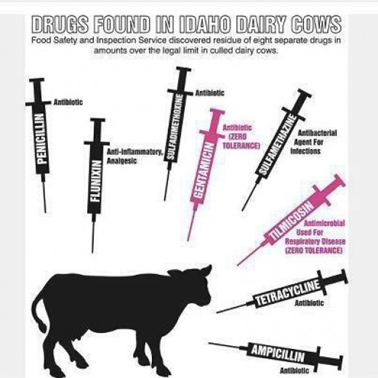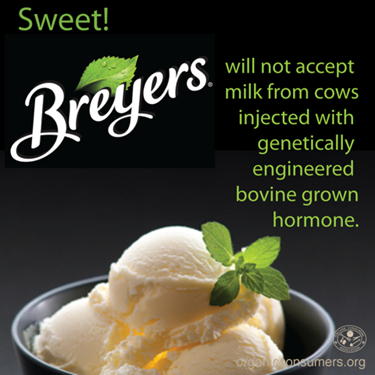Monsanto’s dream is to control the world’s food supply, and that includes the ever popular perennial summertime treat, ice cream. How certain are you that your favorite ice cream is actually Monsanto free? Unless you’ve been living under a rock, you’d know your ice cream could be made from milk or milk products derived from cows injected with Monsanto’s genetically modified rBGH (recombinant bovine growth hormone), sweetened with GM beet sugar, made with milk or cream from cows fed genetically modified soy and corn mush feed or “enhanced” with a HIDDEN array of toxic additives.
First let’s dispel some potential confusion: the genetically engineered, bovine growth hormone (rBGH) is also known as Recombinant Bovine Somatotropin (rBST); In other words, two different names that refer to the exact same bovine growth hormone.
For many years (BGH) or natural bovine growth hormone was used by farmers to increase milk production in dairy cows. But Monsanto had a better idea. They created a genetically engineered version of this natural hormone under the brand name: Posilac (rBST aka rBGH) and it’s now routinely injected into more than a quarter of all U.S. dairy cows.
Maybe you’re still wondering, what’s the real harm from having a little genetically modified, bovine hormone in your ice cream anyway?
- Genetically Engineered Hormones
- Antibiotics
- Puss and Blood
Dr. Richard Burroughs, a veterinarian deeply conversant with rBGH stated: “It [rBGH] results in an increase of white blood cells,” he explains, “which means there’s pus in the milk!” The antibiotic use, he adds, “leaves residues in the milk. It’s all very serious.”
In the book What’s in Your Milk? by Samuel Epstein, MD, a scientist at the University of Illinois School of Public Health, expert on cancer prevention, and outspoken critic of rBGH, nicknamed “crack for cows”, explains:
This [rBGH milk] contains very high levels of a natural growth factor known as IGF-1… . IGF-1 stands for Insulin-like Growth Factor 1. So growth factor 1 is a natural growth factor and is responsible for normal growth but when you drink rBGH milk, you have very, very high levels of this natural growth factor.
When you drink it, the IGF-1 survives digestion and is readily absorbed from your small intestine, into your blood.Increased levels of IGF-1 have been shown to increase risks of breast cancer and we have about 20 publications showing this; risk of colon cancer [shown] by about 10 publications; prostate cancer by about another 10 publications.
And a further concern: increased levels of IGF-1 block natural defense mechanisms against early cancers, [mechanisms] known as ‘apoptosis [cellular suicide].’”
In a Huffington Post article entitled: Is Your Favorite Ice Cream Made with Monsanto’s Artificial Hormones?, John Robbins, son of the founder of the Baskin Robbins Ice Cream Empire states:
“… [I]njecting the genetically engineered hormone into cows increases the levels of a substance called IGF-1 in their milk. Monsanto’s own studies found that the amount of IGF-1 in milk more than doubled when cows were injected with rBGH. Studies by independent researchers show gains as much as six-fold …”
A May 9, 1998 article featured in the medical journal, The Lancet reported: pre-menopausal women with even moderately elevated blood levels of IGF-1 are up to seven times more likely to develop breast cancer than women with lower levels.
Robbins also noted that studies found men (age 60 and over) with high blood levels of IGF-1 to be at an eight times greater risk for prostate cancer compared to men in the same age bracket with low levels of IGF-1.
Correspondingly, premenopausal women with elevated blood levels of IGF-1 had up to a seven times greater risk of breast cancer.
The poor cows injected with Monsanto’s hormone suffer a 25% increase in mastitis (udder infections) and a 50% increase in lameness. Luckily for Monsanto they also sell the antibiotics that they recommend to counteract health problems among rBGH treated cows.
Milk from conventional cows is loaded with antibiotics. If you’re determined to eat healthy, you’ll soon discover that pasteurized milk is not nearly as healthy as raw organic milk from pastured cows. But that’s another article.
The majority of dairy cows in the US are living on corporatized industrial farms, or concentrated animal feeding operations (CAFOs). They’re fed a steady diet of mostly GMO crops such as corn, soy, alfalfa, cotton seed, and/or sugar beets. Shockingly, 98% of GM soy and 49% of GM corn is allocated to feeding livestock and poultry.
Truth in advertising, Huh?
Reality check: if you live in the United States the vast majority of conventional milk and dairy products lining those refrigerated shelves in supermarkets across the country are derived from cows that eat GMO feed and could contain Monsanto’s rBGH or rBST.
Once Monsanto conceived and perfected their GE hormone (rBST) they proceeded to carve out a nice, fat market for it and then sold it to Elanco, a division of the Eli Lilly drug company in 2008.
“Of course, Monsanto (and now Elanco) wants us to think the hormone is in every way completely satisfactory and safe. Monsanto’s party line has consistently been that there is “no significant difference” in the milk derived from cows who have been dosed with the hormone compared to those who haven’t.” – John Robbins
Well then, if it’s so safe why is this genetically engineered, bovine growth hormone banned in Canada, New Zealand, Japan, Australia and all 27 nations of the European Union but is still available in the U.S.?
Eventually, the U.S. government decided to tackle the milk problem. The government strategy involved a two prong approach: pay farmers to slaughter their dairy cows and pay them more to stop all dairy farming for five years! Sadly, over 1.5 million cows were needlessly killed.
IS YOUR STORE BOUGHT OR RESTAURANT ICE CREAM REALLY MONSANTO FREE?
BACKDOOR MONSANTO ICE CREAM
Have you noticed the marketing blitz afoot with several beloved, ice cream giants flooding the airwaves with press releases boasting that their ice cream is now made exclusively from milk and cream from rBGH free cows? That’s good news -kinda. But what about Backdoor GM ice cream?
MILK FROM COWS FED GM-GRAIN IS “MONSANTO” MILK
“According to the Non-GMO Project, an organization that certifies ingredients as non-GMO, (1) milk from a cow fed GM-grain cannot be certified as non-GMO. GMO Inside, one of the organizations leading efforts to label, also abides by this definition.(2) The USDA’s Organic label also adheres to these standards. (3) The Food Babe used the same criteria in her campaign against (4)“Monsanto Milk” in Starbucks beverages. However, Ben & Jerry’s, an ice cream company and one of the first large organizations to declare that it was going GMO-free and (4) supports labeling, sources its milk from cows fed GM-grain.” – Biology Fortified
GM-BEET SUGAR?
Green America reported that GM sugar beets were introduced into the market back in 2005. By 2009 “95 percent of the US sugar-beet crop was genetically modified, according to the USDA. Currently around half of the sugar produced in the US comes from sugar beets.
Beware: If a product contains sugar as an ingredient but does not specify “pure cane sugar,” the sugar is probably a mix of actual cane sugar along with GM sugar beets.
For example, in 2015 ice cream giant, Breyers proudly announced it’s no longer using milk or cream from cows treated with the artificial growth hormone rBGH, which by the way is genetically engineered in a lab from E. coli bacteria. What about accepting milk from cows fed GM feed?
MILK, CREAM, SUGAR, CORN SYRUP, WHEY, EGG YOLKS, CAROB BEAN GUM, MONO AND DIGLYCERIDES, SALT, NATURAL FLAVOR, VANILLA EXTRACT*, ANNATTO (FOR COLOR), GUAR GUM, TARA GUM. Ingredients and Nutrition Facts are current as of 2/11/15. Please see shelf packaging for any changes.
MORE RED FLAGS
Are you starting to wonder if the eggs in the above ingredients list are from unhealthy, confined chickens massively injected with antibiotics and forced to eat a GM diet? What about that corn syrup? It’s likely from GMO corn.
Let’s take a look at Breyer’s Butter Pecan ice cream ingredients.
Like the vanilla ice cream, Breyer’s Butter Pecan is also laden with a stunning array of unhealthy chemicals and questionable additives, but did you notice the cotton seed oil – which is almost guaranteed to be a produced from GMO cotton seeds.
WHAT ABOUT THE PINNACLE OF DECADENT ICE CREAM HAAGEN-DAZS, YOU MAY ASK?
Not to be left out in the cold, Haagen–Dazs has also recently, heavily promoted that it no longer uses rBGH dairy in its ice cream.
Here’s what Haagen–Dazs states on their FAQ’s page:
“rBST is a synthetic hormone given to dairy cows to enhance milk production. We do not source any milk or cream from cows that have been treated with rBST”.
“†No significant difference has been shown between milk from rBST treated and non-rBST treated cows. The suppliers of our other ingredients cannot guarantee that the milk they use comes from non-rBST treated cows.” [emphasis added]
The cows they source their milk and cream from most likely eat GMO feed, as do the chickens they get their eggs from.
Ben & Jerry’s website explains:
But to be clear, the fresh Vermont milk and cream that our family farmers supply to us is not organic. This means that in the US, it is common practice for the cows’ feed to contain GMO ingredients such as corn. Current regulations in most countries with mandatory GMO labeling requirements do not require milk to be labeled as GMO when derived from cows fed GMO feed. This is also consistent with proposed state-level legislation for GMO labeling, specifically dairy from cows fed GMO feed would not be required to be labeled as containing GMO ingredients. This is the current position that Ben & Jerry’s are adopting with regard to animal-derived ingredients.
Under these regulations, this does not make the dairy genetically modified. We think a good analogy is this: if you eat a corn chip containing GMO corn, it doesn’t make you a genetically modified human.
UH OH!
HIDDEN INGREDIENTS COMMONLY FOUND IN STORE BOUGHT ICE CREAM
Did you know ice cream manufacturers are not required by law to list all the additives they put in ice cream sold in stores. Here’s a sampling of some “flavoring” ingredients found in store-bought ice creams:
Source: - wewantorganicfood.com
_______________________________________________________
PLEASE DONATE TODAY, IF the Holy Spirit impresses you, (donate button below and on the side) so I can continue to help others. Thank you! If you can't see the donate button or want quick access – use this link: PayPal.Me/ReneeB
Got info from: http://www.realfarmacy.com/ice-cream-secrets-revealed/








No comments:
Post a Comment